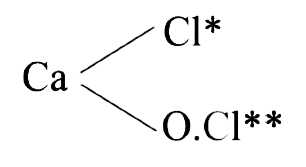The possible oxidation state of two chlorine atoms in bleaching powder (CaOCl2) are
−1,+1
0,0
−1,−1
−1,0
To determine the possible oxidation states of chlorine in bleaching powder (Ca(OCl)₂), we can follow these steps:
Step 1: Identify the components of bleaching powder
Bleaching powder has the formula Ca(OCl)₂. This means it contains calcium (Ca), oxygen (O), and chlorine (Cl).
Step 2: Determine the oxidation state of calcium
Calcium is an alkaline earth metal and typically has an oxidation state of +2. Thus, we assign:
- Oxidation state of Ca = +2
Step 3: Determine the oxidation state of oxygen
Oxygen generally has an oxidation state of -2. In this compound, we have:
- Oxidation state of O = -2
Step 4: Set up the equation for the oxidation states
In the compound Ca(OCl)₂, there are two chlorine atoms. Let’s denote the oxidation state of chlorine as x. The overall charge of the compound must be neutral (0). Therefore, we can set up the equation based on the oxidation states:
+2+2(−2)+2x=0
Step 5: Solve for x
Now, substituting the values we have:
+2−4+2x=0
2x−2=0
2x=2
x=1
Step 6: Determine the oxidation states of chlorine
From the calculations, we find that one oxidation state of chlorine is +1. However, we also need to consider the other common oxidation state of chlorine, which is -1.
Thus, the two possible oxidation states of chlorine in bleaching powder are:
- +1 (in the hypochlorite ion, OCl⁻)
- -1 (in the chloride ion, Cl⁻)
Final Answer
The possible oxidation states of the two chlorine atoms in bleaching powder (Ca(OCl)₂) are +1 and -1.
---
Bleaching powder has the formula Ca(OCl)₂. This means it contains calcium (Ca), oxygen (O), and chlorine (Cl).
Calcium is an alkaline earth metal and typically has an oxidation state of +2. Thus, we assign:
- Oxidation state of Ca = +2
Oxygen generally has an oxidation state of -2. In this compound, we have:
- Oxidation state of O = -2
In the compound Ca(OCl)₂, there are two chlorine atoms. Let’s denote the oxidation state of chlorine as x. The overall charge of the compound must be neutral (0). Therefore, we can set up the equation based on the oxidation states:
+2+2(−2)+2x=0
Now, substituting the values we have:
+2−4+2x=0
2x−2=0
2x=2
x=1
From the calculations, we find that one oxidation state of chlorine is +1. However, we also need to consider the other common oxidation state of chlorine, which is -1.
- +1 (in the hypochlorite ion, OCl⁻)
- -1 (in the chloride ion, Cl⁻)
The possible oxidation states of the two chlorine atoms in bleaching powder (Ca(OCl)₂) are +1 and -1.
Topper's Solved these Questions
Similar Questions
Knowledge Check
The average oxidation state of chlorine in bleaching powder is
A-1B+1CZeroD−2 as well as +2Oxidation numbers of two Cl atoms in belaching powder, CaOCl2, are
A−1, −1B+1, −1C+1, +1D0, −1The oxidation of two Cl atoms in bleaching powder Ca(OCl)Cl is
A−1,−1B+1,−1C+1,+1D0,−1
Oxidation state(s) of chlorine in CaOCl2 (bleaching powder)
View SolutionOxidation state of chlorine in Belacing powder
View SolutionOxidation state of chlorine in hypochlorous acid
View SolutionOxidation state of chlorine in perchloric acid is
View SolutionOxidation numbers of Cl-atoms in CaOCl2 (bleaching powder) :

View Solution
